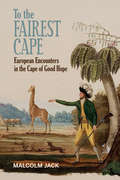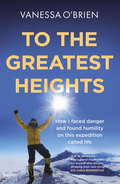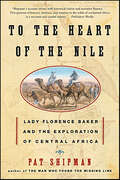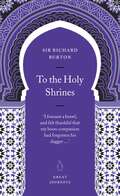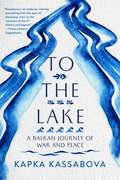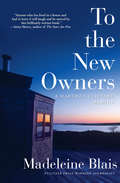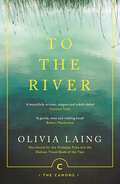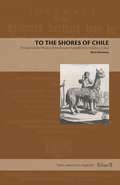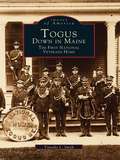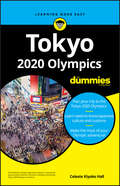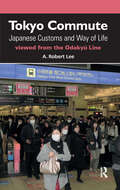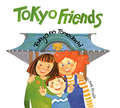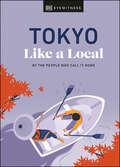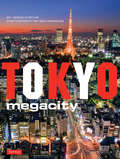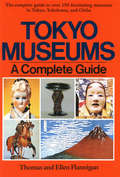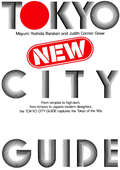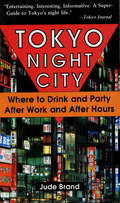- Table View
- List View
To the Fairest Cape: European Encounters in the Cape of Good Hope
by Malcolm JackCrossing the remote, southern tip of Africa has fired the imagination of European travellers from the time Bartholomew Dias opened up the passage to the East by rounding the Cape of Good Hope in 1488. Dutch, British, French, Danes, and Swedes formed an endless stream of seafarers who made the long journey southwards in pursuit of wealth, adventure, science, and missionary, as well as outright national, interest. Beginning by considering the early hunter-gatherer inhabitants of the Cape and their culture, Malcolm Jack focuses in his account on the encounter that the European visitors had with the Khoisan peoples, sometimes sympathetic but often exploitative from the time of the Portuguese to the abolition of slavery in the British Empire in 1833. This commercial and colonial background is key to understanding the development of the vibrant city that is modern Cape Town, as well as the rich diversity of the Cape hinterland. Published by Bucknell University Press. Distributed worldwide by Rutgers University Press.
To the Greatest Heights: One woman's inspiring journey to the top of Everest and beyond
by Vanessa O'Brien'What a wonderful, honest, refreshing book, full of free-spirited adventure, humour and profound thoughts to provide inspiration to anyone who simply dreams of getting out and doing their own thing' SIR CHRIS BONINGTON'Ernest Shackleton listed those qualities an explorer should possess over a century ago: optimism, patience, idealism with imagination, and courage. Vanessa's qualities are truly akin to these' ALEXANDRA SHACKLETONWhen Vanessa O'Brien was made redundant in 2008 as part of the recession, she moved to Hong Kong with her husband for his career and resigned herself to being 'just the wife'. There she was, aged 46, bored, uninspired, unemployed. Was this going to be how she was going to live the rest of her life?One night in the infamous Kee Club, over shots of tequila, a friend suggested O'Brien climb Everest, and that was the start of an epic journey she never looked back from as she climbed Everest, K2 and many other mountains. This is her inspirational story. As O'Brien says, she couldn't explain to her readers how she got to the top of K2 at the age of 52 without being honest about what came before. In To the Greatest Heights, she reveals the trials and tribulations of her difficult childhood, and the result is a life-affirming book that shows how she achieved these climbs in spite of and because of her past. To read To the Greatest Heights is to know that there is a path to overcoming the worst of what happens to us, a path that helps us reach the summit of our lives too, whatever our age.
To the Heart of the Nile: Lady Florence Baker and the Exploration of Central Africa
by Pat ShipmanIn 1859, at age fourteen, Florence Szász stood before a room full of men and waited to be auctioned to the highest bidder. But slavery and submission were not to be her destiny: Sam Baker, a wealthy English gentleman and eminent adventurer, was moved by compassion and an immediate, overpowering empathy for the young woman, and braved extraordinary perils to help her escape. Together, Florence and Sam -- whose love would remain passionate and constant throughout their lives -- forged into literally uncharted territory in a glorious attempt to unravel a mysterious and magnificent enigma called Africa.A stunning achievement, To the Heart of the Nile is an unforgettable portrait of an unforgettable woman: a story of discovery, bravery, determination, and love, meticulously reconstructed through journals, documents, and private papers, and told in the inimitable narrative style that has already won Pat Shipman resounding international acclaim.
To the Holy Shrines
by Richard BurtonDisguised as a Persian dervish, Sir Richard Burton (1821-1890) set out to become the first Christian to penetrate the Muslim shrines of Medina and Mecca - a reckless stunt that would have resulted in his being executed if discovered. Endlessly observant, amused, boastful and engaging, Burton here describes his time in Cairo (including a memorable drinking contest with a ferocious Albanian mercenary captain), his crossing of the Red Sea in a crazily overloaded pilgrim boat and his arrival in the fabled Nejd.Great Journeys allows readers to travel both around the planet and back through the centuries – but also back into ideas and worlds frightening, ruthless and cruel in different ways from our own. Few reading experiences can begin to match that of engaging with writers who saw astounding things: Great civilisations, walls of ice, violent and implacable jungles, deserts and mountains, multitudes of birds and flowers new to science. Reading these books is to see the world afresh, to rediscover a time when many cultures were quite strange to each other, where legends and stories were treated as facts and in which so much was still to be discovered.
To the Lake: A Balkan Journey of War and Peace
by Kapka KassabovaThe celebrated author of Border explores a mysterious, ancient, and little-understood corner of EuropeLake Ohrid and Lake Prespa. Two ancient lakes joined by underground rivers. Two lakes that seem to hold both the turbulent memories of the region’s past and the secret of its enduring allure. Two lakes that have played a central role in Kapka Kassabova’s maternal family. As she journeys to her grandmother’s place of origin, Kassabova encounters a historic crossroads. The lakes are set within the mountainous borderlands of North Macedonia, Albania, and Greece, and crowned by the old Via Egnatia, which once connected Rome to Constantinople. A former trading and spiritual nexus of the southern Balkans, this lake region remains one of Eurasia’s most diverse corners. Meanwhile, with their remote rock churches, changeable currents, and large population of migratory birds, the lakes live in their own time.By exploring on water and land the stories of poets, fishermen, and caretakers, misfits, rulers, and inheritors of war and exile, Kassabova uncovers the human destinies shaped by the lakes. Setting out to resolve her own ancestral legacy, Kassabova locates a deeper inquiry into how geography and politics imprint themselves upon families and nations, one that confronts her with universal questions about human suffering and the capacity for change.
To the New Owners: A Martha's Vineyard Memoir
by Madeleine BlaisThe Pulitzer Prize–winning journalist “gives a familial face to the mystique of Martha’s Vineyard” in a memoir with “gentle humor and . . . elegiac sweetness” (Kirkus Reviews). A National Book Critics Circle Award finalist In the 1970s, Madeleine Blais’s in-laws purchased a vacation house on Martha’s Vineyard. A little more than two miles down a dirt road, it had no electricity or modern plumbing, the roof leaked, and mice had invaded the walls. It was perfect. Sitting on Tisbury Great Pond—well-stocked with delicious oysters and crab—the house faced the ocean and the sky. Though improvements were made, the ethos remained the same: no heat, television, or telephone. Instead, there were countless hours at the beach, meals cooked and savored with friends, nights talking under the stars, until, in 2014, the house was sold. To the New Owners is Madeleine Blais’s “witty and charming . . . deeply felt memoir” of this house, and of the Vineyard itself, from the history of the island and its famous visitors, to the ferry, the pie shops, the quirky charms and customs, and the abundant natural beauty. But more than that, this is an elegy for a special place—a retreat that held the intimate history of her family (The National Book Review).
To the River: A Journey Beneath the Surface (Canons #71)
by Olivia LaingAn author&’s walk &“from source to sea along the Ouse in Sussex is a meandering, meditative delight&” drawing on history, literature, and the river itself (The Guardian, UK). In To The River, author Olivia Laing embarks on a weeklong, midsummer odyssey along the banks of the River Ouse in Sussex, England, from its source near Haywards Heath to the sea, where it empties into the Channel at Newhaven. More than sixty years after Virginia Woolf drowned herself in the River Ouse, Laing still finds inspiration and guidance in the author&’s abiding presence. Through cow pastures, woods, and neighborhood streets, Laing&’s meandering walk occasions a profound and haunting reflection on histories both personal and cultural, and on landscapes both physical and emotional. Along the way, she explores the roles that rivers play in human lives, tracing their intricate flow through literature, mythology and folklore. Lyrical and stirring, To the River is a passionate investigation into how history resides in a landscape - and how ghosts never quite leave the places they love.&“Magical…By turns lyrical, melancholic and exultant, To the River just makes you want to follow Olivia Laing all the way to the sea.&”—Daily Telegraph, UK
To the Shores of Chile: The Journal and History of the Brouwer Expedition to Valdivia in 1643 (Latin American Originals #14)
by Mark MeuweseTo the Shores of Chile presents the remarkable story of an expedition that took place in Latin America during the height of the Dutch Empire. Skillfully translated by Mark Meuwese, this captivating work sheds light on Dutch imperialism and the complicated relationships between Native peoples and European colonizers.In 1643, the Dutch West India Company launched an expedition to the coast of southern Chile. With plans to set up a permanent outpost that they hoped would generate enormous revenues in gold and weaken the position of their Spanish rivals, a naval squadron of five vessels and six hundred and fifty soldiers, sailors, and craftsmen set sail under the direction of Hendrick Brouwer. In the end, lack of cooperation from the native Mapuche stymied the expedition. However, an account of the enterprise, based on the journals and logbooks, was published in Amsterdam in 1646 to capitalize on the public fascination with dangerous adventures of Europeans in exotic places and to serve as a political pamphlet in support of the renewal of the West India Company’s charter.To the Shores of Chile makes this account available for the first time in English and sheds light on both Dutch expansionism and the military and diplomatic power of indigenous people in South America. It will be particularly valuable to ethnohistorians, scholars of failed colonies, and those interested in maritime and Dutch colonial history.
To the Shores of Chile: The Journal and History of the Brouwer Expedition to Valdivia in 1643 (Latin American Originals)
by Mark MeuweseTo the Shores of Chile presents the remarkable story of an expedition that took place in Latin America during the height of the Dutch Empire. Skillfully translated by Mark Meuwese, this captivating work sheds light on Dutch imperialism and the complicated relationships between Native peoples and European colonizers.In 1643, the Dutch West India Company launched an expedition to the coast of southern Chile. With plans to set up a permanent outpost that they hoped would generate enormous revenues in gold and weaken the position of their Spanish rivals, a naval squadron of five vessels and six hundred and fifty soldiers, sailors, and craftsmen set sail under the direction of Hendrick Brouwer. In the end, lack of cooperation from the native Mapuche stymied the expedition. However, an account of the enterprise, based on the journals and logbooks, was published in Amsterdam in 1646 to capitalize on the public fascination with dangerous adventures of Europeans in exotic places and to serve as a political pamphlet in support of the renewal of the West India Company’s charter.To the Shores of Chile makes this account available for the first time in English and sheds light on both Dutch expansionism and the military and diplomatic power of indigenous people in South America. It will be particularly valuable to ethnohistorians, scholars of failed colonies, and those interested in maritime and Dutch colonial history.
Tobacco Valley
by Tobacco Valley Board of History Gary MontgomeryThe Tobacco Valley, in Montana's far northwest corner, was so named by explorer David Thompson in 1808 upon finding the resident natives using a form of wild tobacco. The Kutenai Indians were the primary inhabitants until late in the 19th century when cattlemen found the isolated valley. By 1890, several ranching families moved cattle overland to fatten on pasture that heretofore knew only the track of a Kutenai Indian pony. Eureka came into being when the Great Northern Railroad was built through in 1904. With what seemed like limitless timber, a lumber mill was operating by 1906. The railroad brought in workers and entrepreneurs, hauling lumber out. Early on it was thought that farming might supplement the timber-based economy, but hopeful homesteaders soon learned that the Tobacco Valley would never deliver on the promise of fruits and vegetables. Harvesting timber would define the Tobacco Valley for decades to come.
Togus, Down in Maine: The First National Veterans Home
by Timothy L. SmithTogus, located 4.5 miles east of Augusta, Maine, was formerly part of the town of Chelsea. After the Civil War, Congress enacted laws and established a system of facilities that collectively became known as "National Homes for Disabled Volunteer Soldiers." The critical need to establish an eastern branch of the National Home led to the selection of the former Togus Spring Hotel, which after some remodeling, opened for Union Civil War veterans inNovember 1866. Gathered from cherished family albums, collectors of Togus artifacts, libraries, and archives, Togus, Down in Maine: The First National Veterans Home represents the first published history of the area, and most of the photographs have not been viewed by the public. The images of Civil War veterans are of particular interest, along with views of buildings, barracks, and hospitals from 1866 to the 1930s. From 1932 to 1960, over 60 buildings were demolished, and new buildings with reinforced concrete and brick facings were built.
Tokyo 2020 Olympics For Dummies
by Celeste Kiyoko HallMake the most of your 2020 Olympic adventure! If you dream of traveling to the Olympic games but feel overwhelmed by the thought of a trip to Japan, then Tokyo 2020 Olympics For Dummies is for you. Hundreds of thousands of international travelers will arrive in Tokyo for the next Olympics to share in the worldwide camaraderie and watch world-class athletes in 33 sports. This book is your complete authority on how to join in! Learn about travel options, safety, customs, and facts about the Olympic Games. Tokyo is an amazing destination, and you’ll be prepared for the voyage of a lifetime with knowledge of Japanese culture and trip planning tips. Plan your trip to the 2020 Olympic Games in Tokyo, Japan Be prepared with tips on Japanese culture, customs, language, and more Learn about how the Olympic Games are structured to make the best of your time Stay stress free and have fun with international travel advice and Olympic facts! As you prepare for your once-in-a-lifetime excursion, keep this guide within easy reach!
Tokyo Commute: Japanese Customs and Way of Life Viewed from the Odakyu Line
by Robert LeeA unique take on modern life in Tokyo. A Japan of trains, every day to and fro, carriage scenes and theatre, vistas from the window, advertising posters. To be savoured through the Odakyu line. Pitched as creative text and line-graphics, Tokyo Commute offers on-track and off-track observations. Poetics of Japanese routine and etiquette.
Tokyo Fashion City: A Detailed Guide to Tokyo's Trendiest Fashion Districts
by Philomena Keet Yuri ManabeThe fashionable, eccentric pedestrians of Tokyo are captured with hundreds of portrait photographs in this fun guide to Tokyo street fashion.Tokyo is considered one of the world's style capitals for its vibrant youth fashion culture. Part guide book, part fashion photography album, Tokyo Fashion City takes a stroll through eight Tokyo neighborhoods, each with its own unique fashion characteristics, to see what streetwise young Tokyoites are wearing, where they're shopping, what they're eating and drinking, and where they're hanging out.Author Philomena Keet and photographer Yuri Manabe accompany the reader to Harajuku where high fashion rubs shoulders with hip-hop style; to Shibuya, birthplace of the "gal" and stomping ground for Tokyo's most sophisticated fashionistas; to hipster hangout Daikanyama; to the goth and geek meccas of Shinjuku and Ikebukuro; to bohemian Koenji and otaku neighborhood Nakano; to Ginza's lunching ladies and dapper gentlemen; to the cosplay paradise of Akihabara; and to the narrow lanes of East Tokyo, where everyday Japanese fashion gets a traditional touch.Each chapter is packed with photographs of young fashionistas captured as they go about their daily lives, with info-rich captions, and insightful text giving the background to the trends and tribes featured.
Tokyo Friends
by Betty ReynoldsThis multicultural children's book is a a kid-friendly introduction to Japanese culture!Katie is a young American girl living in present-day Tokyo. One day, as she walks her dog, she meets Keiko, a young Japanese girl, and her brother Kenji. <P><P>Join Katie, Keiko and Kenji as they explore the city and its surroundings as they learn about cultural diversity and the customs of their respective countries. Whether eating soba (buckwheat noodles) or spaghetti, studying kana (the alphabet), or dancing at the O-bon festival, the friends discover just how much their two cultures differ--and how much they are alike.Vibrantly illustrated by the author, Tokyo Friends is a wonderful Japanese children's book that introduces young readers to Japanese traditions and customs and also serves well as a valuable beginner's guide to the Japanese language.
Tokyo Guida di viaggio: Guida tascabile di Tokyo e non solo
by Adidas WilsonTokyo è senza dubbio una delle destinazioni turistiche più famose del Giappone. Offre attrazioni per ogni stagione e vorrete sempre tornare a visitarla. In primavera si può ammirare lo spettacolo mozzafiato dei ciliegi in fiore e i colori dell’autunno presentano una vista meravigliosa. E in estate? Tokyo dovrebbe essere sulla vostra lista dei desideri se state cercando una destinazione magica dove trascorrere l’estate da soli o con gli amici e la famiglia. Oltre ai festival estivi abbondano le attrattive e i luoghi di interesse e divertimento, tra cui musei, vie dello shopping, cibo, giardini tradizionali giapponesi e verdi parchi lussureggianti. Nonostante tutti questi aspetti straordinari Tokyo può presentare qualche difficoltà per i visitatori durante l’estate per via del clima caldo-umido. Per vostra fortuna, i consigli contenuti in questa guida vi aiuteranno a orientarvi in questa grande città e a vivere un’esperienza straordinaria.
Tokyo Like a Local: By the People Who Call It Home (Local Travel Guide)
by DK Eyewitness Kaila Imada Lucy DaymanKeen to explore a different side of Tokyo? Like a Local is the book for you.This isn&’t your ordinary travel guide. You won&’t find the Tokyo Tower and the Imperial Palace, in these pages, because that&’s not where Tokyoites hang out. Instead, you&’ll meet the locals in iconic anime shops, modern art galleries, or whilst paddle boring along the scenic Okutama River - and that&’s where this book takes you. Turn the pages to discover: The small businesses and community strongholds that add character to this vibrant city, recommended by true locals.6 themed walking tours dedicated to specific experiences such as vintage shopping and manicured gardens.A beautiful gift book for anyone seeking to explore Tokyo.Helpful &‘what3word&’ addresses, so you can pinpoint all the listed sights.Compiled by two proud locals and revised and updated for 2023, this stylish travel guide is packed with Tokyo&’s best experiences and secret spots, handily categorized to suit your mood and needs.Whether you&’re a restless Tokyoite on the hunt for a new hangout, or a visitor keen to discover a side you won&’t find in traditional guidebooks, Tokyo Like A Local will give you all the inspiration you need. About Like A Local:These giftable and collectable guides from DK Eyewitness are compiled exclusively by locals. Whether they&’re born-and-bred or moved to study and never looked back, our experts shine a light on what it means to be a local: pride for their city, community spirit and local expertise. Like a Local will inspire readers to celebrate the secret as well as the iconic – just like the locals who call the city home. Looking for another guide to Tokyo? Explore further with our DK Eyewitness or Top 10 guides to Tokyo.
Tokyo Megacity
by Donald Richie Ben SimmonsModern Tokyo is a city of strata, in which the patchwork of villages that make its surface so varied are matched by the slices of the past that remain. The city combines the old and the new, and is both traditional and trendy. This diversity, this variety, this livability, this adventure is captured in both the text and the photographs of Tokyo Megacity.A visual and verbal exploration of Tokyo, now the largest city in the world, this gorgeous book features approximately 250 photos by well-known photographer Ben Simmons, accompanied by 31 essays by author Donald Richie. A new look at an astonishing city, Tokyo Megacity begins with an exploration of the ancient roots of old Edo and follows the evolution of the city to modern day.
Tokyo Megacity
by Donald Richie Ben SimmonsModern Tokyo is a city of strata, in which the patchwork of villages that make its surface so varied are matched by the slices of the past that remain. The city combines the old and the new, and is both traditional and trendy. This diversity, this variety, this livability, this adventure is captured in both the text and the photographs of Tokyo Megacity.A visual and verbal exploration of Tokyo, now the largest city in the world, this gorgeous book features approximately 250 photos by well-known photographer Ben Simmons, accompanied by 31 essays by author Donald Richie. A new look at an astonishing city, Tokyo Megacity begins with an exploration of the ancient roots of old Edo and follows the evolution of the city to modern day.
Tokyo Museum Guide
by Thomas Flannigan Ellen FlanniganTokyo affords no better-or cheaper-day trip than a visit to one of its many fascinating museums. Now for the first time in English is a complete guide to all the museums, large and small, general and specific, in the Tokyo and Yokohama areas. Tokyo has everything for the expert and the casual observer alike. Superb exhibits include the collection of Oriental antiquities at the Tokyo National Museum and an old-Tokyo neighborhood recreated in the Fukagawa Edo Museum. Whatever your interests-from poetry to parasites-Tokyo has a museum for you. The authors, Thomas and Ellen Flannigan, who personally visited all the museums, give excellent advice on what to see,and what to avoid.
Tokyo New City Guide
by Judith Connor Greer Mayumi Yoshida BarakanThe Tokyo New City Guide goes far beyond the well-worn tourist itineraries and deep into the complex, highly contrasted heart of one of the world's largest and most exciting cities. This lively, up-to-the-minute city guide covers Tokyo of the 1990s like no other. Here's where you will find the ideal balance between the still-extant traditional Japan with its temples, way of life, arts and crafts, kimono, festivals, customs and cuisine and the crowded futuristic technopolis of electronics, high fashion, contemporary art and architecture, and gastronomic experiences from the four corners of the globe.
Tokyo New Wave: 31 Chefs Defining Japan's Next Generation, with Recipes
by Andrea FazzariShowcasing the new talent of Tokyo's vibrant food scene, Andrea Fazzari profiles 31 chefs who are shaping the future of one of the world's most dynamic cities. In a luxe collection filled with portraits, interviews, and recipes, author and photographer Andrea Fazzari explores the changing landscape of food in Tokyo, Japan. A young and charismatic generation is redefining what it means to be a chef in this celebrated food city. Open to the world and its influences, these chefs have traveled more than their predecessors, have lived abroad, speak other languages, and embrace social media. Yet they still remain distinctly Japanese, influenced by a style, tradition, and terroir to which they are inextricably linked. This combination of the old and the new is on display in Tokyo New Wave, a transporting cookbook and armchair travel guide that captures this moment in Japanese cuisine and brings it to a savvy global audience.
Tokyo Night City Where to Drink & Party
by Judith BrandTokyo Night Citywill take you on a trek through the previously unmapped maze of Tokyo's myriad bars, clubs, and dives.Cool jazz clubs, Latin salsa, throbbing house, and reggae bars, Tokyo Night Cityhas the place for every mood and every pocket and includes:*The latest information on drinks, music and prices*Addresses, phone numbers, and maps from the nearest station*Appendixes detailing late eats and where to party in Yokohama
Tokyo Night City Where to Drink & Party
by Judith BrandTokyo Night Citywill take you on a trek through the previously unmapped maze of Tokyo's myriad bars, clubs, and dives.Cool jazz clubs, Latin salsa, throbbing house, and reggae bars, Tokyo Night Cityhas the place for every mood and every pocket and includes:*The latest information on drinks, music and prices*Addresses, phone numbers, and maps from the nearest station*Appendixes detailing late eats and where to party in Yokohama
Tokyo On Foot: Travels in the City's Most Colorful Neighborhoods
by Florent ChavouetThis prize-winning book is both an illustrated tour of a Tokyo rarely seen in Japan travel guides and an artist's warm, funny, visually rich, and always entertaining graphic memoir.<P><P>Florent Chavouet, a young graphic artist, spent six months exploring Tokyo while his girlfriend interned at a company there. Each day he would set forth with a pouch full of color pencils and a sketchpad, and visit different neighborhoods. This stunning book records the city that he got to know during his adventures. It isn't the Tokyo of packaged tours and glossy guidebooks, but a grittier, vibrant place, full of ordinary people going about their daily lives and the scenes and activities that unfold on the streets of a bustling metropolis.Here you find business men and women, hipsters, students, grandmothers, shopkeepers, policemen, and other urban types and tribes in all manner of dress and hairstyles. A temple nestles among skyscrapers; the corner grocery anchors a diverse assortment of dwellings, cafes, and shops--often tangled in electric lines. The artist mixes styles and tags his pictures with wry comments and observations. Realistically rendered advertisements or posters of pop stars contrast with cartoon sketches of iconic objects or droll vignettes.
